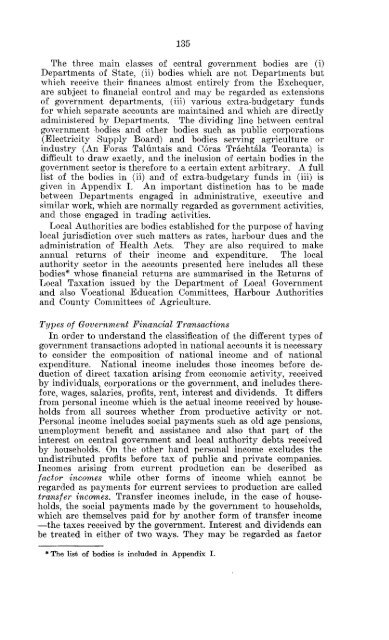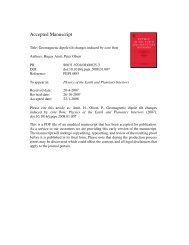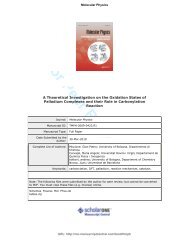An Analysis of Government Revenue and Expenditure in ... - TARA
An Analysis of Government Revenue and Expenditure in ... - TARA
An Analysis of Government Revenue and Expenditure in ... - TARA
You also want an ePaper? Increase the reach of your titles
YUMPU automatically turns print PDFs into web optimized ePapers that Google loves.
135<br />
The three ma<strong>in</strong> classes <strong>of</strong> central government bodies are (i)<br />
Departments <strong>of</strong> State, (ii) bodies which are not Departments but<br />
which receive their f<strong>in</strong>ances almost entirely from the Exchequer,<br />
are subject to f<strong>in</strong>ancial control <strong>and</strong> may be regarded as extensions<br />
<strong>of</strong> government departments, (iii) various extra-budgetary funds<br />
for which separate accounts are ma<strong>in</strong>ta<strong>in</strong>ed <strong>and</strong> which are directly<br />
adm<strong>in</strong>istered by Departments. The divid<strong>in</strong>g l<strong>in</strong>e between central<br />
government bodies <strong>and</strong> other bodies such as public corporations<br />
(Electricity Supply Board) <strong>and</strong> bodies serv<strong>in</strong>g agriculture or<br />
<strong>in</strong>dustry (<strong>An</strong> Foras Taluntais <strong>and</strong> Coras Trachtala Teoranta) is<br />
difficult to draw exactly, <strong>and</strong> the <strong>in</strong>clusion <strong>of</strong> certa<strong>in</strong> bodies <strong>in</strong> the<br />
government sector is therefore to a certa<strong>in</strong> extent arbitrary. A full<br />
list <strong>of</strong> the bodies <strong>in</strong> (ii) <strong>and</strong> <strong>of</strong> extra-budgetary funds <strong>in</strong> (iii) is<br />
given <strong>in</strong> Appendix I. <strong>An</strong> important dist<strong>in</strong>ction has to be made<br />
between Departments engaged <strong>in</strong> adm<strong>in</strong>istrative, executive <strong>and</strong><br />
similar work, which are normally regarded as government activities,<br />
<strong>and</strong> those engaged <strong>in</strong> trad<strong>in</strong>g activities.<br />
Local Authorities are bodies established for the purpose <strong>of</strong> hav<strong>in</strong>g<br />
local jurisdiction over such matters as rates, harbour dues <strong>and</strong> the<br />
adm<strong>in</strong>istration <strong>of</strong> Health Acts. They are also required to make<br />
annual returns <strong>of</strong> their <strong>in</strong>come <strong>and</strong> expenditure. The local<br />
authority sector <strong>in</strong> the accounts presented here <strong>in</strong>cludes all these<br />
bodies* whose f<strong>in</strong>ancial returns are summarised <strong>in</strong> the Returns <strong>of</strong><br />
Local Taxation issued by the Department <strong>of</strong> Local <strong>Government</strong><br />
<strong>and</strong> also Vocational Education Committees, Harbour Authorities<br />
<strong>and</strong> County Committees <strong>of</strong> Agriculture.<br />
Types <strong>of</strong> <strong>Government</strong> F<strong>in</strong>ancial Transactions<br />
In order to underst<strong>and</strong> the classification <strong>of</strong> the different types <strong>of</strong><br />
government transactions adopted <strong>in</strong> national accounts it is necessary<br />
to consider the composition <strong>of</strong> national <strong>in</strong>come <strong>and</strong> <strong>of</strong> national<br />
expenditure. National <strong>in</strong>come <strong>in</strong>cludes those <strong>in</strong>comes before deduction<br />
<strong>of</strong> direct taxation aris<strong>in</strong>g from economic activity, received<br />
by <strong>in</strong>dividuals, corporations or the government, <strong>and</strong> <strong>in</strong>cludes therefore,<br />
wages, salaries, pr<strong>of</strong>its, rent, <strong>in</strong>terest <strong>and</strong> dividends. It differs<br />
from personal <strong>in</strong>come which is the actual <strong>in</strong>come received by households<br />
from all sources whether from productive activity or not.<br />
Personal <strong>in</strong>come <strong>in</strong>cludes social payments such as old age pensions,<br />
unemployment benefit <strong>and</strong> assistance <strong>and</strong> also that part <strong>of</strong> the<br />
<strong>in</strong>terest on central government <strong>and</strong> local authority debts received<br />
by households. On the other h<strong>and</strong> personal <strong>in</strong>come excludes the<br />
undistributed pr<strong>of</strong>its before tax <strong>of</strong> public <strong>and</strong> private companies.<br />
Incomes aris<strong>in</strong>g from current production can be described as<br />
factor <strong>in</strong>comes while other forms <strong>of</strong> <strong>in</strong>come which cannot be<br />
regarded as payments for current services to production are called<br />
transfer <strong>in</strong>comes. Transfer <strong>in</strong>comes <strong>in</strong>clude, <strong>in</strong> the case <strong>of</strong> households,<br />
the social payments made by the government to households,<br />
which are themselves paid for by another form <strong>of</strong> transfer <strong>in</strong>come<br />
—the taxes received by the government. Interest <strong>and</strong> dividends can<br />
be treated <strong>in</strong> either <strong>of</strong> two ways. They may be regarded as factor<br />
* The list <strong>of</strong> bodies is <strong>in</strong>cluded <strong>in</strong> Appendix I.
















